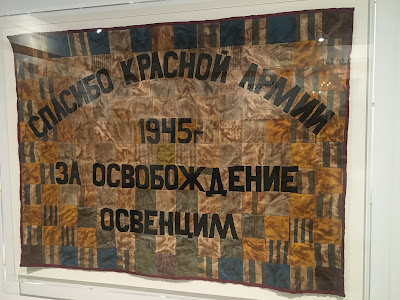This visit was very interesting and very sobering. We spent a lot more time here than we anticipated.
Upon arrival we saw this boxcar in the parking lot.
After a four year, international search, this 10-ton WWII era boxcar was found in Austria and purchased by a Museum Board Member and Past President. It was moved to Naples in 2008 to honor his parents, as well as in memory of other family members that were lost during the Holocaust.
It is a rare artifact and among only eleven that are located throughout the US. These boxcars moved millions of Jews and other "undesirables" to labor/concentration/death camps throughout Europe during Hitler's reign. Many of those who found themselves in these cars did not survive the trip.
Upon entering the museum this large photomosaic of 13 year old Anne Frank greets you. It's approximately 6-8' square and is made up of 7000 photographs.
Irv was our docent and provided a lot of information during the 1 1/2 hour tour. He has traveled to several of the camp remains in Europe and personally knows survivors. One of his best friends, who recently passed away, survived as a small child and is in one of the photos in the museum.
The museum was located about eight miles south in a rented space and only moved into this space two months ago, so it's a work in progress but is owned, rather than rented.
The red circle on the floor is barbed wire and the one below is butterflies.
There are currently three rooms, each representing a time during Hitler's reign. Irv described them as "worse", "worser" and "worsest". He knew it wasn't good grammar but felt it aptly described each time period, at least as far as the Jews were concerned.
There was so many pictures and articles that I couldn't possibly take pictures of each one but these were a couple that struck a chord with me.
This is a bronze sculpture titled the "Train Track Sculpture" by Julia Balk. "As the figures on one side of the tracks look out from the past, the viewer, on the other side" (of the tracks) "gazes in at them from the present." There are also figures on the back side but it was too dark to take a picture.
This was my favorite piece...
"According to the Museum's sources and further research, this quilt was sewn by surviving Auschwitz inmates", from their clothing. "Written in Russian, it says "Thank you Red Army for the Liberation of Auschwitz, 1945." Wow! I mean, how can that not touch your soul?
As I said, there were camps throughout Europe but not all of them were death camps. However, this tells how many were murdered at each killing center...
Special Command Units were made up of prisoners that were "tasked with removing the bodies, cleaning the gas chambers, and then destroying the bodies, either in crematoria or makeshift "ovens" using railroad tracks as grating". Can you even imagine?
It is unfathomable to me that there are people who honestly believe that the Holocaust is fake and didn't really happen. I believe one of the reasons for that is that children are not being taught about it in school; however, there are about twelve states that now require students learn about this atrocity. Sadly, neither Maine nor Massachusetts are among them.
If you like to read, the book "Mila 18", by Leon Uris, is about the Polish ghetto during the war and it paints a very good picture of what life was like during that time. I've read it several times and I guess it's time to read it again. I would consider it historical fiction.
Thanks for stopping by...
;o)
Subscribe to:
Post Comments (Atom)













No comments:
Post a Comment